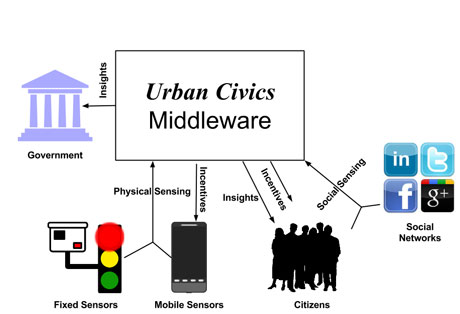by Sara Hachem, Valérie Issarny, Alexey Pozdnukhov and Rajiv Bhatia
The Urban Civics project brings together a multi-disciplinary, trans-atlantic team of experts working towards a common goal that citizens and governments collaborate in achieving participatory democracy in healthy cities.
Technologies that bring together the emerging visions for smart, connected and resource-efficient cities, and the revolutions in social media and mobile networking, offer unprecedented opportunities for participatory democracy, health and sustainability. Early proponents of Smart Cities have advanced the idea of hyper-connected city information systems as a means of promoting operational efficiency and natural resources conservation. However, the idea of citizen participation in the design and control of these systems has been missing. In democratic political systems, optimization in cities also means being responsive to the observations, attitudes and demands of their citizens.
The widespread adoption of social networking and mobile communication, as well as the Internet-of-Things (IoT), citizen-science and open data, generate new information resources for understanding the needs and preferences of citizens from government services. Information generated via citizen science and crowd sensing sources, are particularly good at reflecting the priorities and perceptions of citizens. Inclusive and participatory, “smarter” cities can integrate and leverage these diverse information resources to improve responsiveness to citizens and improve the urban quality of life. For example, environmental conflicts such as air and noise pollution can be better managed. Still, supporting participatory information gathering at urban scales, and integrating that sensed data into information that is relevant to urban governance and moreover, actionable, remains a major research issue. The Urban Civics project tackles this challenge by bringing together a multi-disciplinary team of experts, so that citizens and governments may work together toward healthy cities.
In a nutshell, Urban Civics is developing, from the design to prototype implementation, a middleware solution that tackles the following research question (Figure 1): ‘How can urban data sources be leveraged and comprehensively integrated to accurately capture nuisance issues facing our cities?’. We have specifically concentrated on addressing the following associated research challenges:

- How can we develop a distributed system architecture that leverages the richness of the urban sensors of the new digital era (featuring IoT, open data, citizen science, social networking and mobile computing) at large scales? Our approach lies in leveraging relevant probabilistic protocols to overcome the urban scale challenges together with building upon semantic Web technologies to aggregate physical and social data sources [1].
- How can we ensure citizen participation? Our approach lies in studying dedicated machine-learning algorithms (e.g., see [2]), to mine leadership and thereby prompt citizen participation, as well as optimizing data collection strategies through incentive-driven, pro-active citizen engagement and a more informed approach to crowd-sensing.
- How can we assimilate the rich urban data to develop significant city models? We address this challenge by building on the assimilation of observations that deal with time-varying distributions, and take into account both model and observational errors to produce the most accurate map of the monitored phenomenon (e.g., see [3]).
The Urban Civics middleware solution applies to a variety of environmental issues that our cities are currently facing. Indeed, the physical and social sensing approach implemented by Urban Civics remains similar across use-cases dedicated to environment monitoring. Specifically, the approach requires plugging dedicated sensors to provide quantitative data and applications to enable end-users to provide qualitative data, both of which are aggregated through data modelling & assimilation functionalities. The mathematical details vary depending on the use-case specific phenomenon. As an illustration, we discuss noise pollution and air quality below:
- Noise pollution, i.e., the undesired sounds that harm one’s well being, come from several sources including traffic, neighbors and construction works. Noise can be measured using a microphone, hosted on sound/noise level meters which can be deployed throughout a city. However, whilst highly accurate, static sensors alone cannot account for the fine-grained spatial variations that occur.. Consequently, smartphone microphones can be exploited as a complementary data source; end-users describe noise levels through a dedicated application plugged in with Urban Civics. Additional information can also be automatically extracted from social networks, e.g., if users are attending a public event at the measurement time. Once the various inputs are provided, the data is analyzed and proper city models (of noise pollution) are generated.
- Air quality monitoring, in particular the tracking of nitrogen dioxide (which is mostly emitted from vehicles), can be performed by deploying static sensors throughout a city. Further, since smartphones do not yet host sensors that can monitor air pollution, end-users can themselves be equipped with such sensors and can provide their own qualitative input to describe air quality at their locations. Data assimilation for air quality is already applied in Paris and leveraged in several cities in France. However, urban-scale air quality monitoring is still challenged by the required deployment of sensors, which is made much more tractable using Urban Civics and its diverse urban sensors.
Urban Civics is under active development, as part of larger research initiatives oriented toward Smart Cities that are being launched by both University of California, Berkeley, and Inria. The initiatives will promote collaboration between the two organisations. In parallel, we are working closely with the city administration to acquire insights on the broad applicability of Urban Civics.
Link:
CityLab@Inria Project Lab on Smart Cities: http://citylab.inria.fr
References:
[1] S. Hachem, A. Pathak, V. Issarny: “Service-oriented middleware for large-scale mobile participatory sensing”, Pervasive and Mobile Computing, 2014
[2] F. Kling, A. Pozdnoukhov: “When a city tells a story: urban topic analysis”, in proc. of the 20th International Conference on Advances in Geographic Information Systems, 2012
[3] A. Tilloy et al.: “BLUE-based NO2 data assimilation at urban scale”, Journal of Geophysical Research, 118(4), 2013.
Please contact:
Valerie Issarny,
Inria@Silicon Valley, France, USA
E-mail:











